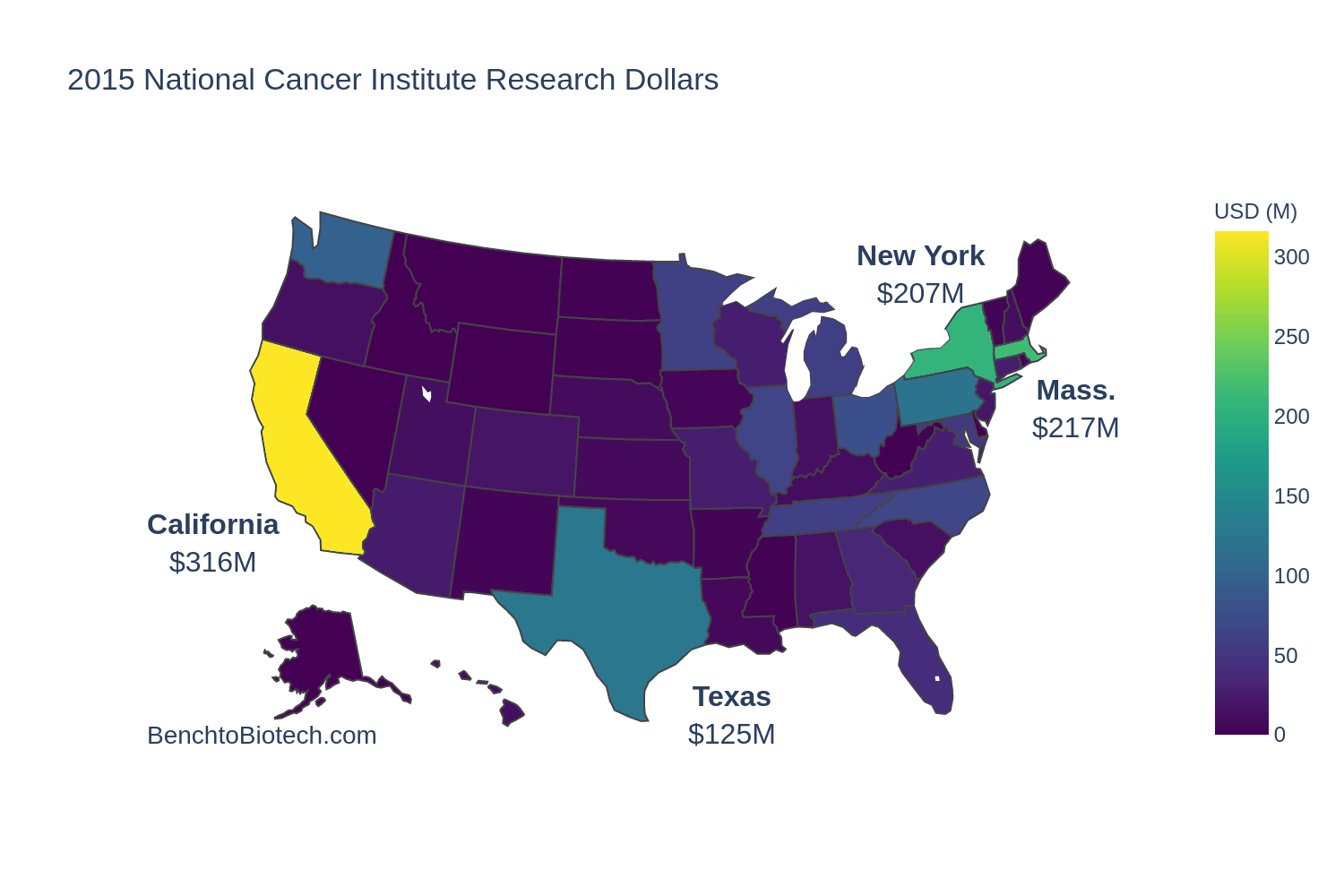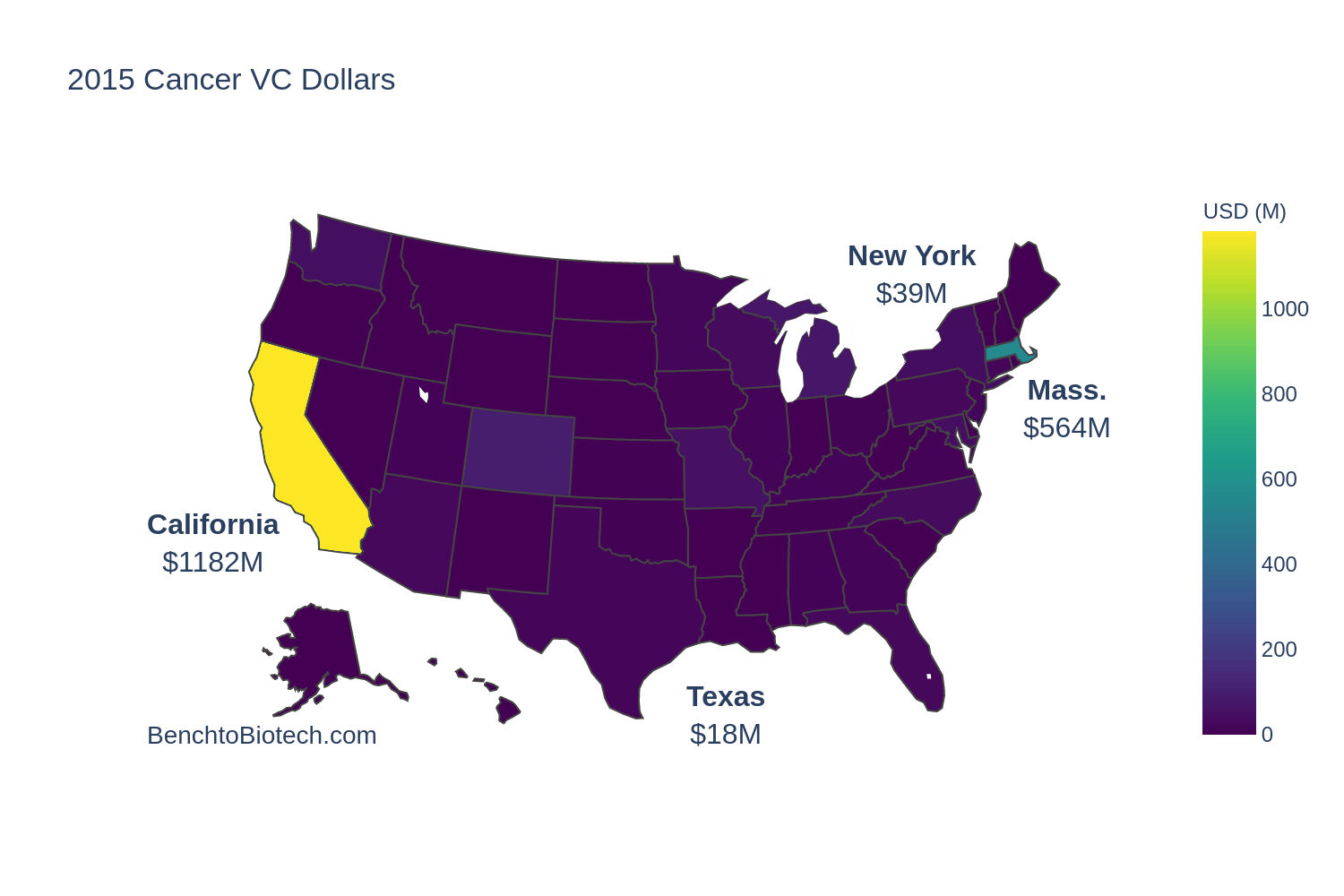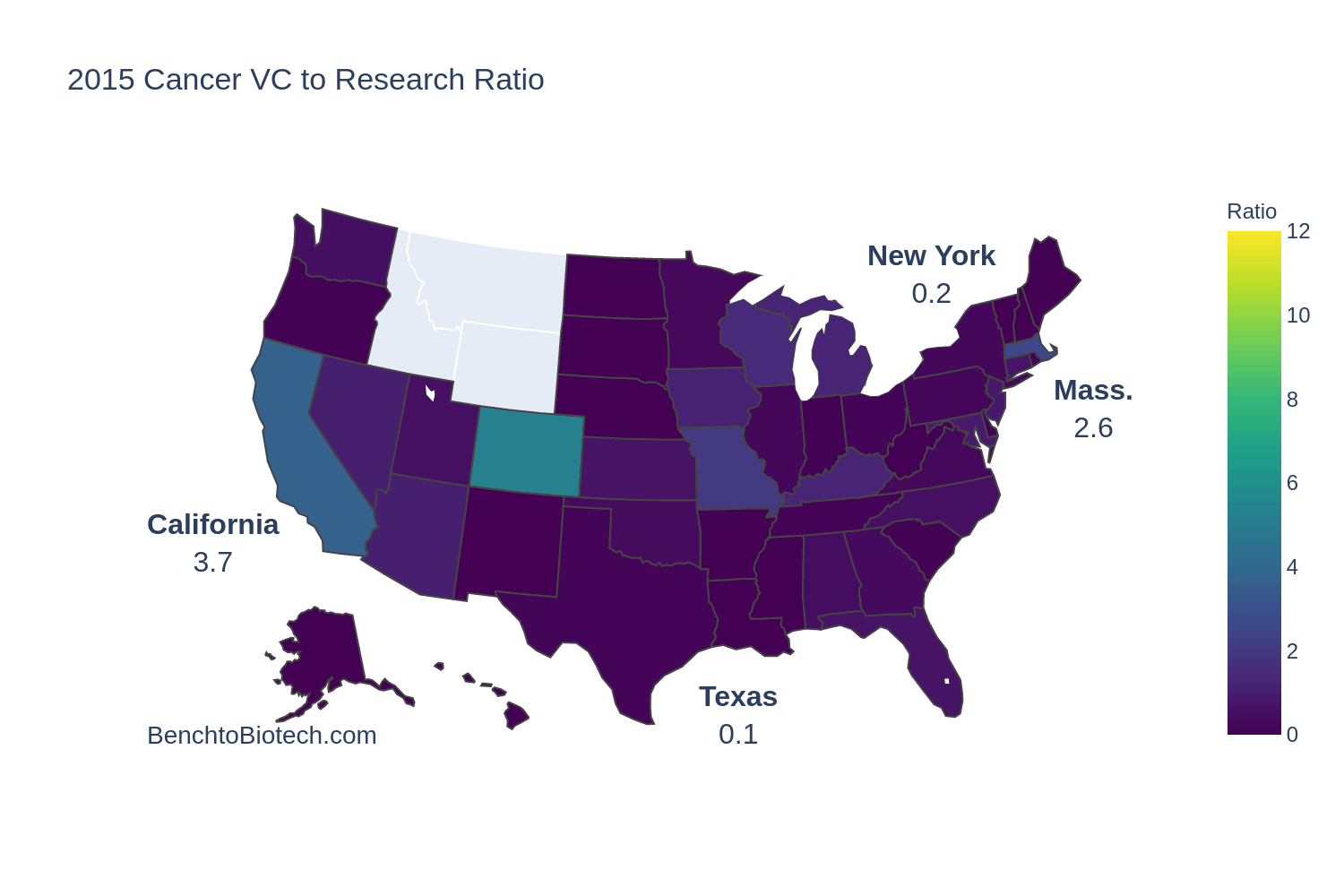Investment gaps in cancer biotech (and why you should bet on Texas)
This year, I will be helping to launch the Accelerator for Cancer Therapeutics here in Houston, Texas. Let's be clear - Houston is NOT considered a biotech hub and this is a very unique program. So why are we starting this in Houston, and not San Francisco or Boston?
One contrary belief that led me to make this choice was my conviction that Houston (and Texas) had an enormous amount of cancer research that wasn't being efficiently brought to the clinic.
Some points supporting Texas' unique expertise in cancer:
- We have two NCI-designated Comprehensive Cancer Centers across the street from each other (MD Anderson Cancer Center and the Baylor College of Medicine), with another in Dallas (UT Southwestern).
- We have the world's largest children's hospital with over 250 cancer-focused clinical trials ongoing
- The Texas Medical Center collectively serves 10 million patients visits per year across 9,200 beds
- The Cancer Prevention Research Institute of Texas (CPRIT) is a $3B fund that has funded $1.7B in research and $437M in product development since 2010
- CPRIT was just renewed in 2019 for another $3B dollars in the coming 10 years, setting the stage for a flywheel effect
But what about the second assertion - that this research is not being brought to the clinic? Given the cost of drug approval most therapeutics get to the clinic via a commercial entity, increasingly in small biopharma.
There have been several very large deals just this year based on Texas technologies
- AlloVir: $276M IPO
- Peloton Therapeutics: $2.2B acquisition by Merck
- Shattuck Labs: $232M IPO
Notably, 2 of 3 here were primarily commercialized outside of Texas, even though the technology came from Texas research centers. This is potentially creating a knowledge and community gap which makes additional development more, not less, difficult.

Digging into the numbers
Let's start with an initial premise. Cancer research should convert into therapeutic candidates at some rate, which would subsequently be commercialized. As I said, the majority of drug development is occurring in small biopharma, typically with an end-goal of large pharma acquisition. That requires a lotta moola, typically venture investment. So we should be able to track commercialization rates by comparing the research dollars to venture investments.
NCI Research Dollars
In order to simplify this analysis, we will set aside the substantive research funding from CPRIT as a fair comparison would require tracking down the various local foundation and economic development funds across the country. For the purposes of exploring the basic premise (how does research convert to commercial activity) the absolute numbers are less important than the trend.
That said, CPRIT is the largest local development fund focused on cancer in the United States, so it bears keeping in mind that there will be substantive research potential not counted in this analysis.
For now we'll sally forth with the biggest funder of biomedical research in the United States: the NIH. In this case, we'll focus on just the National Cancer Institute (NCI).
Nothing terribly surprising here. The top four NCI funded states are California, Massachusetts, New York, and Texas. California and Massachusetts house the two "biotech hubs" (San Francisco and Boston) and are adjacent to satellite hubs (San Diego, La Jolla, New Jersey, and NYC). And Texas has the world's largest medical center and the world's largest cancer hospital.

Research Dollars
| CA | MA | NY | TX | |
|---|---|---|---|---|
| 2015 | 316.4 | 216.9 | 206.9 | 125.4 |
| 2016 | 329.9 | 229.2 | 212.1 | 127.8 |
| 2017 | 355.5 | 245.8 | 225.5 | 150.1 |
| 2018 | 355.1 | 260.1 | 250.9 | 167 |
| 2019 | 365.6 | 266.1 | 265 | 179.5 |
Cancer-related Venture Investments
This is a little difficult to track visually, since California and Massachusetts garner the vast majority of venture investment across the country. Biotech is booming across the board, and the multiples of growth here ranges from 3x (California) to 17x (NY). In multiples, New York and Texas are growing faster than California or Massachusetts, but the sheer scale of growth in California ($2B in 5 years) will have some interesting effects as we parse a little further.

Venture Investment
| CA | MA | NY | TX | |
|---|---|---|---|---|
| 2015 | 1181.8 | 563.7 | 39.5 | 18.5 |
| 2016 | 1729.9 | 533.8 | 146 | 78.4 |
| 2017 | 2896.6 | 966.4 | 63 | 120.2 |
| 2018 | 2674.6 | 1763 | 279.5 | 163.1 |
| 2019 | 3136.2 | 1889.5 | 682 | 248.9 |
Cancer-related Venture Dollars per NCI Research Dollar
As a first pass at understanding the relative conversion of research into commercialization activity, I did a simple ratio of venture dollars to research dollars. Again, the rate of investment is picking up across the board, but the geographical differences have resulted in either an overinvestment in the hubs, or an underinvestment elsewhere, depending on where you're standing.
One huge problem with cutting the data this way is that some areas have so little research and investment that small changes create weird artifacts. Look at how Montana lights up like a Christmas tree in 2019, even though there was no investment previously.
Another thing we can't tell from ratios is the scale of the disparity. You would expect a location with low levels of research activity to have relatively low investment. Further, there is a fair argument that the apparent overinvestment in the hubs is due to the Flywheel Effect of a mature ecosystem - ie 1 + 1 = 3.

VC Dollars per Research Dollar
| CA | MA | NY | TX | |
|---|---|---|---|---|
| 2015 | 3.7 | 2.6 | 0.2 | 0.1 |
| 2016 | 5.2 | 2.3 | 0.7 | 0.6 |
| 2017 | 8.1 | 3.9 | 0.3 | 0.8 |
| 2018 | 7.5 | 6.8 | 1.1 | 1 |
| 2019 | 8.6 | 7.1 | 2.6 | 1.4 |
Cancer-related Commercialization Gap (vs National average)
In order to determine whether there is a commercialization gap, and therefore quantify how much missed investment opportunity there might be, we need to:
- Measure the difference from a baseline (the National value)
- Multiply that gap by local research activity
Leading to the following formula:
( (VCNational/ResearchNational) - (VCstate/Researchstate) ) * Researchstate
What we see here, as a single measure, is what we were trying to understand between the previous analyses. All of the states (except California and Massachusetts) started out with relatively similar commercialization activity relative to their research dollars.
- Negative values here are overinvested in comparison to the national average
- Positive values are underinvested (ie a "positive" gap)
The graphics speak for themselves. In just the last five years, the gaps have become more and more extreme. Whether California is "overinvested" or simply setting the standard is a matter of perspective. The changes are happening so fast we don't have the exit (or failure) data to say for certainty.
But what we can see is that the other major research hubs are lighting up as large-scale missed opportunities.
By 2019, Texas has the largest gap, about $350 M in missed opportunities assuming you were otherwise investing equally across the country. But you're probably not. There is a $2.25B gap between California and Texas.

Cancer Commercialization Gap (vs National)
| CA | MA | NY | TX | |
|---|---|---|---|---|
| 2015 | -794.9 | -298.5 | 213.6 | 134.8 |
| 2016 | -1240.6 | -193.8 | 168.6 | 111.2 |
| 2017 | -2059.2 | -387.4 | 468.1 | 233.4 |
| 2018 | -1595 | -972.3 | 483.1 | 344.4 |
| 2019 | -1915.9 | -1001.4 | 202.5 | 350.5 |
So what does this all mean?
Look, I didn't exactly bury the lead here. You can probably guess where I'm going with this. Year on year, New York and Texas are growing faster than California or Massachusetts, the two major biotech hubs. But, and this is a big but, the sheer scale of investment in those hubs has compounded the differences in the regions.
New York is a bit interesting here. They are a major research hub in their own right, but much of the commercial activity occurs in nearby Boston. The premise of the missed opportunity analysis is that the technologies are either not being commercialized or the rate of development is slowed due to geographical limitations creating a connectivity barrier to investors and other resources. Whether either of these is true for New York, with Boston next door, is unclear.
Texas is equally not close to both coasts. The technologies developed here do find investment - more every year - but there is a lot of value left on the table. Without a thriving ecosystem, only the "obviously" good can get enough attention to be invested in and subsequently developed. But the best ideas are often not obvious, and are even ignored and derided for years.
Remember: Research not commercialized is not helping patients.
That's what we're all here for, at the end of the day. But the goal in investing, even if you are impact-driven, is to make money. I'd argue that looking more closely at deals in Texas is both interesting for finding innovative treatments and as an investment arbitrage opportunity.
Methods
Code and method notes for this analysis:


